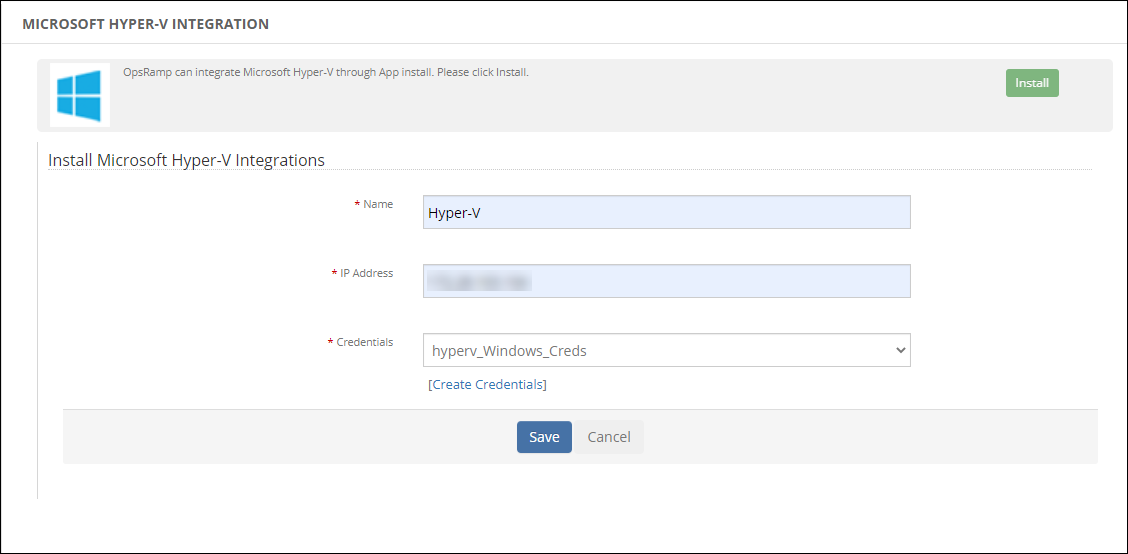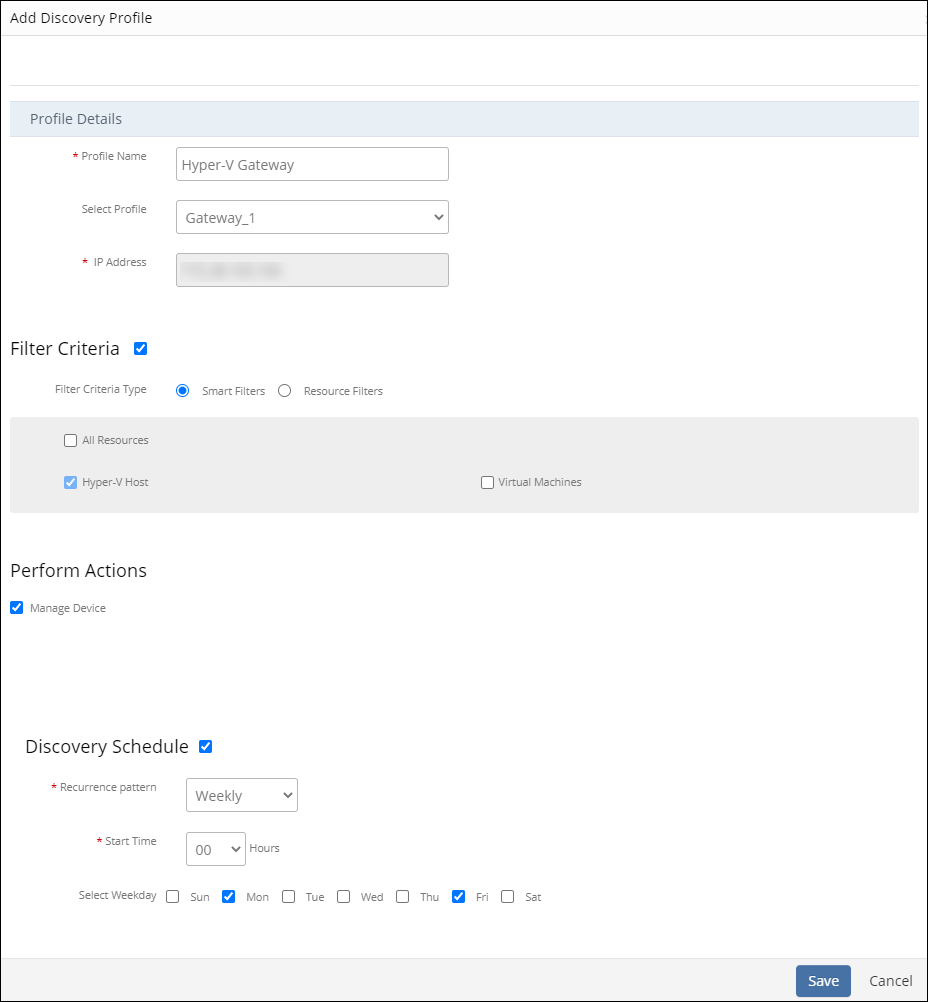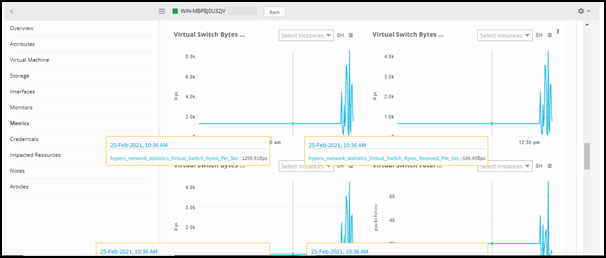Microsoft Hyper-V, an important part of the enterprise IT infrastructure environment is a hypervisor-based virtualization solution. Integrating Hyper-V to OpsRamp allows you to:
- View and monitor infrastructure resources managed by Hyper-V hosts.
- Manage bottlenecks and optimize performance.
- Improve system performance.
- Track and observe resources to ensure zero downtime.
- Eliminate overall system performance degradation and SLAs.
You can use local or domain users while authenticating the target Hyper-V host and get the monitoring updates.
Prerequisite
- On the gateway resource:
- Enable WinRM services.
- Allow WinRM service through the firewall.
- Enable PowerShell remoting using the command:
Enable-PSRemoting -Force. - Set PowerShell environment variable on the gateway resource.
If the target device is not in the same domain, add the target device domain to the trusted hosts (The device is discovered in an IP range).
- On the target resource:
- Enable WinRM service.
- Allow WinRM service through the firewall.
- Enable PowerShell remoting using the command:
Enable-PSRemoting -Force.
- Windows gateway version 9.0 or later.
- Port(5985) is in Open state.
Monitor Hyper-V
Monitoring Hyper-V hosts involves:
- Creating credentials.
- Installing and configuring the integration.
- Adding a discovery profile.
- Viewing the Hyper-V infrastructure details
- Assigning a monitoring template.
- Viewing resource metrics.
Step 1: Create credentials
To create credentials:
- Go to Setup > Accounts > Clients.
- Click a Client Name.
- From the client’s Credentials tab, click + Add and provide the following details:
- Name: Provide a name for the credentials.
- Description: Provide a brief description of the purpose of the credentials.
- Type: Select Windows credential type.
- Domain Name: Provide the domain details according to the credential type.
- Username and password: Provide credentials to access Hyper-V.
- Click Save.
The Credentials tab displays the credential details.
Step 2: Install and configure an integration
- From All Clients, select a client.
- Go to Setup > Integrations > Integrations.
- From Available Integrations, select Compute > Microsoft Hyper-V.
- Click Install.
- From Install Microsoft Hyper-V Integrations, provide the following details:
- Name: Provide a name for the integration.
- IP Address: Provide the IP address of Hyper-V
- Credentials: Select the credentials from the list of credentials displayed in the drop-down menu.
- Click Save.

Step 3: Add a discovery profile
To add a discovery profile:
- From the Discovery Profiles tab, click + Add.
- From the Add Discovery Profile window, provide the following Profile Details:
- Profile Name: Provide a name for the discovery profile.
- Select Profile: Select a management profile from the list of profiles listed in the drop-down menu.
- IP Address: Displays the IP address of Hyper-V.
- From the Filter Criteria section, filter for resources that you want to discover using one of the following:
- Smart Filters: To filter resources based on the resource type. Select one of the following:
- All Resources
- Hyper-V Host (Default selection and cannot be changed)
- Virtual Machines
- Resource Filters: To filter resources based on certain resource attributes.
- Select matching criteria to match Any or All rules.
- Filter for resources using the following attributes: resource type, attribute name, logical operator, and value.
Note: Use regular expressions to filter resources using logical operator Regex.
- Smart Filters: To filter resources based on the resource type. Select one of the following:
- From the Perform Actions section, select Manage Device to set the resources as managed.
- From the Discovery Schedule section, schedule the discovery process using the recurrence pattern.
To schedule the discovery process:- Select the Discovery Schedule checkbox.
- From Recurrence Pattern, select one of the following:
- Hourly
- Daily
- Weekly
- Monthly
Set the time intervals depending on the recurrence pattern option selected.
- Click Save.
Discovery triggers based on the scheduled time.

Step 4: View the Hyper-V Infrastructure details
Hyper-V is now successfully integrated and appears in the Infrastructure > Microsoft Hyper-V category. Click the name to view details. The monitoring is enabled according to the configured metric criteria.

Step 5: Assign the monitoring template
To assign monitoring templates to Hyper-V, see Assigning Templates. Monitoring Hyper-V provides the following details:
- Hypervisor CPU Usage: Tracks if the CPUs are running at full capacity or underutilized.
- Hyper-V System Services: Monitors the availability and status of critical Hyper-V services such as Hyper-V Image management service, Virtual Machine Management, and Networking management service.
- Memory Usage: Notifies when the memory usage is high or critically low.
- Networking and Virtual Network Statistics: Monitors the health and status of the network interfaces, virtual network adapters, legacy virtual network adapters, and virtual switch.
- Storage and Virtual Storage Metrics: Metrics to track the saturated drives.
- Hyper-V Performance Monitoring: Monitors the overall performance of Hyper-V servers over some time and analyzes possible trends to ensure high up-time.
For more information on Hyper-V templates, see Hyper-V.
Step 6: View resource metrics
To confirm the monitoring of Hyper-V resource, review the following:
- The graph is plotted for each metric that is enabled in the configuration.
- Alerts are generated for metrics that are configured as per defined integration.

Supported metrics
The following table shows the supported resource components and corresponding metrics.
| Hyper-V Component Name | Metric Name | Display Name | Units |
|---|---|---|---|
| Hyper-V Host | hyperv_system_services_Networking_Management_Service | Hyperv Networking Management Service | - |
| hyperv_system_services_Virtual_System_Management_Service | Hyperv Virtual System Management Service | - | |
| hyperv_system_services_Image_Management_Service | Hyperv Image Management Service | - | |
| hyperv_memory_usage_Total_Remote_Physical_Pages | Total Remote Physical Pages | count | |
| hyperv_memory_usage_Deposited_Pages | Deposited Pages | Count | |
| hyperv_memory_usage_Virtual_Memory_In_GB | Virtual Memory | Giga Bytes(GB) | |
| hyperv_memory_usage_Virtual_TLB_Pages | Virtual TLB Pages | Count | |
| hyperv_memory_usage_Available_MBytes | Available MBytes | Mega Bytes(MB) | |
| hyperv_memory_usage_Total_Physical_Memory_In_GB | Total Physical Memory | Giga Bytes(GB) | |
| hyperv_memory_usage_Page_File_Usage | Page File Usage | Count | |
| hyperv_memory_usage_SwapMemoryUsage_In_GB | Swap Memory Usage | Giga Bytes(GB) | |
| hyperv_cpu_usage_Idle_CPU_Utilization | Idle CPU Utilization | Percentage(%) | |
| hyperv_cpu_usage_Guest_CPU_Utilization | Guest CPU Utilization | Percentage(%) | |
| hyperv_cpu_usage_Hypervisor_CPU_Utilization | Hypervisor CPU Utilization | Percentage(%) | |
| hyperv_cpu_usage_Total_CPU_Utilization | Total CPU Utilization | Percentage(%) | |
| hyperv_network_statistice_Network_Adapters_Packets_Per_Sec | - | Packets/sec | |
| hyperv_network_statistics_Legacy_Network_Adapters_Bytes_Received_Per_Sec | Legacy Network Adapters Bytes Received | Bytes/sec | |
| hyperv_network_statistics_Network_Adapters_Packets_Sent_Per_Sec | Network Adapters Packets Sent | Packets/sec | |
| hyperv_network_statistics_Network_Adapters_Bytes_Total_Per_Sec | Network Adapters Total Bytes | Bytes/sec | |
| hyperv_network_statistics_Virtual_Switch_Bytes_Sent_Per_Sec | Virtual Switch Bytes Sent | Bytes/sec | |
| hyperv_network_statistics_Virtual_Switch_Packets_Sent_Per_Sec | Virtual Switch Packets Sent | Packets/sec | |
| hyperv_network_statistics_Virtual_Switch_Packets_Received_Per_Sec | Virtual Switch Packets Received | Packets/sec | |
| hyperv_network_statistics_Virtual_Switch_Packets_Per_Sec | Virtual Switch Total Packets | Packets/sec | |
| hyperv_network_statistics_Virtual_Switch_Bytes_Per_Sec | Virtual Switch Bytes Per Sec | Bytes/sec | |
| hyperv_network_statistics_Virtual_Switch_Bytes_Received_Per_Sec | Virtual Switch Bytes Received | Bytes/sec | |
| hyperv_network_statistics_Legacy_Network_Adapters_Bytes_Dropped | Legacy Network Adapters Bytes Dropped | Bytes/sec | |
| hyperv_network_statistics_Network_Adapter_Packets_Received_Per_Sec | - | Packets/sec | |
| hyperv_network_statistics_Network_Adapters_Bytes_Sent_Per_Sec | Network Adapters Bytes Sent | Bytes/sec | |
| hyperv_network_statistics_Legacy_Network_Adapters_Bytes_Sent_Per_Sec | Legacy Network Adapters Bytes Sent | Bytes/sec | |
| hyperv_network_statistics_Legacy_Network_Adapters_Frames_Sent_Per_Sec | Legacy Network Adapters Frames Sent | Frames/sec | |
| hyperv_network_statistics_Network_Adapters_Bytes_Received_Per_Sec | Network Adapters Bytes Received | Bytes/sec | |
| Hyperv_Storage_Disk | hyperv_storage_disk_Healthy_Status | Storage Disk Healthy Status | - |
| hyperv_storage_disk_Operational_Status | Storage Disk Operational Status | - | |
| hyperv_storage_disk_Utilization | Storage Disk Utilization | Percentage(%) | |
| hyperv_storage_statistics_Physical_Disk_Transfer_Per_Sec | Physical Disk Transfer | Transfer/sec | |
| hyperv_storage_statistics_Logical_Disk_Transfer_Per_Sec | Logical Disk Transfer | Transfer/sec | |
| hyperv_storage_statistics_Physical_Disk_Bytes_Per_Sec | Physical Disk Bytes Per Sec | Bytes/sec | |
| hyperv_storage_statistics_Logical_Disk_Bytes_Per_Sec | Logical Disk Bytes Per Sec | Bytes/sec | |
| hyperv_storage_statistics_Physical_Disk_Queue_Length | Physical Disk Queue Length | - | |
| hyperv_storage_statistics_Logical_Disk_Queue_Length | Logical Disk Queue Length | - |
Limitations
The resource type of hyper-v host changes from “Microsoft Hyper-V” to “server” on the Infrastructure listing page while installing agent on Hyper-V host.